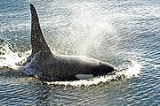
Michael Bigg
Encyclopedia
Michael Bigg was a Canadian marine biologist who is recognized as the founder of modern research on killer whales. With his colleagues, he developed new techniques for studying killer whales and conducted the first population census of the animals. Bigg's work in wildlife photo-identification
enabled the longitudinal study of individual killer whales, their travel patterns, and their social relationships in the wild, and revolutionized the study of cetaceans.
in 1939, Bigg's family moved to the west coast of Canada when he was eight years old. In his youth, Bigg enjoyed exploring the British Columbia
wilderness. According to his father, newspaper publisher Andy Bigg, Michael's early life experiences ingrained in him an immense love of nature. Bigg attended Cowichan Senior Secondary School in Duncan, BC
and then the University of British Columbia
, where he studied falcon
s, water shrew
s, and harbour seals. His Ph.D., awarded in 1972, was based on the reproductive ecology of harbour seals.
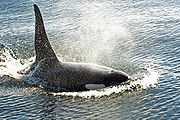 In recent decades, the public has come to appreciate and be fascinated by killer whales. However, for at least a century before the mid-1960s, killer whales were widely feared as dangerous, savage predators, a reputation based on rumour and speculation. In the waters of the Pacific Northwest
In recent decades, the public has come to appreciate and be fascinated by killer whales. However, for at least a century before the mid-1960s, killer whales were widely feared as dangerous, savage predators, a reputation based on rumour and speculation. In the waters of the Pacific Northwest
, the shooting of killer whales was accepted and even encouraged by governments. The mid 1960s and early 1970s saw the development of public and scientific awareness of the species, starting with the first live-capture and display of an killer whale known as Moby Doll
, that had been harpooned off Saturna Island
in 1964.
Bigg's first technique was to send 15,000 questionnaires to boaters, lighthouse keepers, fishermen, and others who frequented the B.C. coast, asking them to record killer whale sightings on one day. No other animal census of this kind had been performed anywhere in the world. The results of the survey, taken on July 27, 1971, indicated that the number of killer whales in the B.C. region of the area was at most 350, drastically fewer than had been assumed. Similar surveys in the following two years and subsequent work with photo-identification techniques (described below), substantiated the results.
In 1976, Bigg submitted his report, indicating that the rate of captures from such a small population was unsustainable and recommending restrictions on the capture of killer whales from Canadian waters. The same year, the U.S. National Marine Fisheries Service
conducted a killer whale survey in the Washington coast, which also yielded low numbers, and public opinion had begun to turn against whale capture. Since 1976, no killer whales in B.C. or Washington waters have been taken for captivity, with the exception of Miracle, a young whale that had been discovered starving and with bullet wounds. Killer whales for aquaria continued to be taken from Iceland
until 1989, when that country banned further captures. Since that time, although orca populations at marine parks are in decline, only a few small-scale captures have occurred, in Argentina, Japan and Russia.
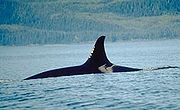
In the early 1970s, Bigg and his colleagues discovered that individual killer whales can be identified from a good photograph of the animal's dorsal fin
and saddle patch, taken when it surfaces. Variations such as nicks, scratches, and tears on the dorsal fin, and the pattern of white or grey in the saddle patch, are sufficient to distinguish killer whales from each other.
Although it had been recognized that some animals could be identified from obvious distinctive features, such as scars, Bigg and his colleagues discovered that the dorsal fin and saddle patch area of every killer whale was sufficiently distinctive to allow the individual to be reliably identified at sea using photographic techniques. The technique enabled the local population of killer whales to be counted each year rather than estimated. It also allowed longitudinal study
of individual whales, their travel patterns, and their social relationships
in the wild, and revolutionized the study of cetaceans. Just a few years previously, whale research had meant studying captive or dead animals, and the study of living wild whales had been virtually nonexistent.
For killer whales, researchers arbitrarily chose the left side of the animal as the one to be used for identification. Bigg's team of killer-whale photographers and spotters quickly grew to include hundreds of volunteers from along the coast, a project that was eventually formalized in 1999 as the B.C. Cetacean Sightings Network. In 1975, researchers examining thousands of black-and-white photographs began to assemble a catalog containing a photograph of every killer whale in British Columbia's waters, a catalog that has been continually updated and used to this day.
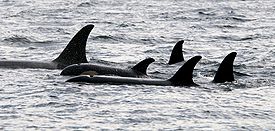 During this time Bigg, together with friends and associates, assembled what has been described as "one of the most thorough data sets for any wild mammal... the killer whale was transformed from one of the least known to among the best understood of all cetaceans." His records included births, deaths, diet, and social associations. Bigg and his colleagues gathered enough data to produce a complete family tree documenting the maternal-side relationships of every killer whale on the B.C. and Washington coasts.
During this time Bigg, together with friends and associates, assembled what has been described as "one of the most thorough data sets for any wild mammal... the killer whale was transformed from one of the least known to among the best understood of all cetaceans." His records included births, deaths, diet, and social associations. Bigg and his colleagues gathered enough data to produce a complete family tree documenting the maternal-side relationships of every killer whale on the B.C. and Washington coasts.
One of the key discoveries of Bigg's team was that there were two types of killer whales living near the British Columbia coastline: residents which ate almost exclusively fish, and transients which hunted marine mammals and other warm-blooded prey. Resident and transient killer whale societies are separate, and the two types tend to avoid each other. The resident killer whale population of B.C. and Washington is further divided into two communities, one northern and one southern, that do not interbreed.
Another discovery was that resident killer whales have one of the most stable social
structures of any animal species. Pods of killer whales had previously been assumed to consist of a few adult males and a harem of potential female mates. Bigg's team slowly realized that killer whale pods are matrilineal: Killer whales travel not with their mates, but with their mothers and maternal relatives. The basis of resident killer whale groupings is the rule that each animal travels primarily with its mother throughout their lives.
Although his research was based in the eastern North Pacific, Bigg mentored killer whale researchers from around the world, who sought his advice for their own studies.
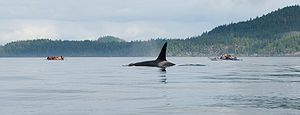 Although he is best known for his work with killer whales, Bigg spent most of his career studying other marine mammals. He researched northern fur seal
Although he is best known for his work with killer whales, Bigg spent most of his career studying other marine mammals. He researched northern fur seal
s in B.C. and the Pribilof Islands
of Alaska. In 1972, Bigg organized a translocation of sea otters
from Alaska to Vancouver Island, a population that continues to thrive. He also conducted research on Steller sea lions, California sea lion
s, and harbour seals.
. While ill, he continued to work to complete his final report on killer whales, and was able to see it in print shortly before he died on 18 October 1990. He was 51. Bigg was survived by a son, a daughter, two sisters, and his parents.
Bigg's ashes were scattered in Johnstone Strait
. Attendees, and the press, noted that more than thirty killer whales appeared in the waters in time for the ceremony. The Robson Bight Ecological Reserve in Johnstone Strait, which was designated as a killer whale sanctuary in 1982, was renamed the Robson Bight (Michael Bigg) Ecological Reserve. The reserve includes one of the few "rubbing beaches" in the world, where killer whales gather to rub against smooth underwater pebbles.
A female resident killer whale, born shortly before Bigg's death in 1990, is unofficially named "M.B." (her official name is G46). The Dr. Michael Bigg Memorial Bursary was created at the University of Victoria
for students of marine biology.
A male Southern Resident killer whale of J pod was named after Bigg, having been born in the year Bigg died. This whale is known as "Mike" (as given by the Whale Museum) and has an alphanumerical designation of J26 (as given by the Center for Whale Research).
Wildlife photo-identification
Photo-identification is a technique used into identify and track individuals of a wild animal study population over time. It relies on capturing photographs of distinctive characteristics such as skin patterns and scars from the animal...
enabled the longitudinal study of individual killer whales, their travel patterns, and their social relationships in the wild, and revolutionized the study of cetaceans.
Early life
Born Michael Andrew Bigg in LondonLondon
London is the capital city of :England and the :United Kingdom, the largest metropolitan area in the United Kingdom, and the largest urban zone in the European Union by most measures. Located on the River Thames, London has been a major settlement for two millennia, its history going back to its...
in 1939, Bigg's family moved to the west coast of Canada when he was eight years old. In his youth, Bigg enjoyed exploring the British Columbia
British Columbia
British Columbia is the westernmost of Canada's provinces and is known for its natural beauty, as reflected in its Latin motto, Splendor sine occasu . Its name was chosen by Queen Victoria in 1858...
wilderness. According to his father, newspaper publisher Andy Bigg, Michael's early life experiences ingrained in him an immense love of nature. Bigg attended Cowichan Senior Secondary School in Duncan, BC
Duncan, British Columbia
Duncan is a city on southern Vancouver Island in British Columbia, Canada.-History:The community is named after William Chalmers Duncan . He arrived in Victoria in May 1862, then in August of that year he was one of the party of a hundred settlers which Governor Douglas took to Cowichan Bay...
and then the University of British Columbia
University of British Columbia
The University of British Columbia is a public research university. UBC’s two main campuses are situated in Vancouver and in Kelowna in the Okanagan Valley...
, where he studied falcon
Falcon
A falcon is any species of raptor in the genus Falco. The genus contains 37 species, widely distributed throughout Europe, Asia, and North America....
s, water shrew
Water Shrew
Water Shrew may refer to any of several species of semi-aquatic red-toothed shrews:*Asiatic water shrews **Malayan Water Shrew **Himalayan Water Shrew **Sunda Water Shrew...
s, and harbour seals. His Ph.D., awarded in 1972, was based on the reproductive ecology of harbour seals.
Killer whale research

Pacific Northwest
The Pacific Northwest is a region in northwestern North America, bounded by the Pacific Ocean to the west and, loosely, by the Rocky Mountains on the east. Definitions of the region vary and there is no commonly agreed upon boundary, even among Pacific Northwesterners. A common concept of the...
, the shooting of killer whales was accepted and even encouraged by governments. The mid 1960s and early 1970s saw the development of public and scientific awareness of the species, starting with the first live-capture and display of an killer whale known as Moby Doll
Moby Doll
Moby Doll was the first captive orca displayed in a public aquarium exhibit.The 15 foot long, 1-ton male was captured in 1964 near East Point, Saturna Island in British Columbia. A sculptor, Samuel Burich, had been commissioned by the Vancouver Aquarium to kill an orca in order to construct a...
, that had been harpooned off Saturna Island
Saturna Island
Saturna Island is a mountainous island, about 31 km² in size, in the Southern Gulf Islands chain of British Columbia. It is situated approximately midway between the Lower Mainland of B.C. and Vancouver Island, and is the most easterly of the Gulf Islands. It is surrounded on three sides by...
in 1964.
Census
Between 1962 and 1973, at least 47 killer whales from the B.C. and Washington coasts were captured for display in captivity, and at least 12 more whales died during capture attempts. It was assumed that the killer whale population in these waters numbered in the thousands; however, as a standard wildlife-management practice for "harvestable" animals, the Canadian government determined that a census should be done. In 1970, Bigg became head of marine mammal research at the Canadian Department of Fisheries and Oceans Pacific Biological Station in Nanaimo, B.C. and was given the task of the census.Bigg's first technique was to send 15,000 questionnaires to boaters, lighthouse keepers, fishermen, and others who frequented the B.C. coast, asking them to record killer whale sightings on one day. No other animal census of this kind had been performed anywhere in the world. The results of the survey, taken on July 27, 1971, indicated that the number of killer whales in the B.C. region of the area was at most 350, drastically fewer than had been assumed. Similar surveys in the following two years and subsequent work with photo-identification techniques (described below), substantiated the results.
In 1976, Bigg submitted his report, indicating that the rate of captures from such a small population was unsustainable and recommending restrictions on the capture of killer whales from Canadian waters. The same year, the U.S. National Marine Fisheries Service
National Marine Fisheries Service
The National Marine Fisheries Service is a United States federal agency. A division of the National Oceanic and Atmospheric Administration and the Department of Commerce, NMFS is responsible for the stewardship and management of the nation's living marine resources and their habitat within the...
conducted a killer whale survey in the Washington coast, which also yielded low numbers, and public opinion had begun to turn against whale capture. Since 1976, no killer whales in B.C. or Washington waters have been taken for captivity, with the exception of Miracle, a young whale that had been discovered starving and with bullet wounds. Killer whales for aquaria continued to be taken from Iceland
Iceland
Iceland , described as the Republic of Iceland, is a Nordic and European island country in the North Atlantic Ocean, on the Mid-Atlantic Ridge. Iceland also refers to the main island of the country, which contains almost all the population and almost all the land area. The country has a population...
until 1989, when that country banned further captures. Since that time, although orca populations at marine parks are in decline, only a few small-scale captures have occurred, in Argentina, Japan and Russia.
Photo-identification techniques

In the early 1970s, Bigg and his colleagues discovered that individual killer whales can be identified from a good photograph of the animal's dorsal fin
Dorsal fin
A dorsal fin is a fin located on the backs of various unrelated marine and freshwater vertebrates, including most fishes, marine mammals , and the ichthyosaurs...
and saddle patch, taken when it surfaces. Variations such as nicks, scratches, and tears on the dorsal fin, and the pattern of white or grey in the saddle patch, are sufficient to distinguish killer whales from each other.
Although it had been recognized that some animals could be identified from obvious distinctive features, such as scars, Bigg and his colleagues discovered that the dorsal fin and saddle patch area of every killer whale was sufficiently distinctive to allow the individual to be reliably identified at sea using photographic techniques. The technique enabled the local population of killer whales to be counted each year rather than estimated. It also allowed longitudinal study
Longitudinal study
A longitudinal study is a correlational research study that involves repeated observations of the same variables over long periods of time — often many decades. It is a type of observational study. Longitudinal studies are often used in psychology to study developmental trends across the...
of individual whales, their travel patterns, and their social relationships
Social animal
A social animal is a loosely defined term for an organism that is highly interactive with other members of its species to the point of having a recognizable and distinct society.All mammals are social to the extent that mothers and offspring bond...
in the wild, and revolutionized the study of cetaceans. Just a few years previously, whale research had meant studying captive or dead animals, and the study of living wild whales had been virtually nonexistent.
For killer whales, researchers arbitrarily chose the left side of the animal as the one to be used for identification. Bigg's team of killer-whale photographers and spotters quickly grew to include hundreds of volunteers from along the coast, a project that was eventually formalized in 1999 as the B.C. Cetacean Sightings Network. In 1975, researchers examining thousands of black-and-white photographs began to assemble a catalog containing a photograph of every killer whale in British Columbia's waters, a catalog that has been continually updated and used to this day.
Killer whale taxonomy and social structure
In 1976, federal funding for Bigg's killer whale research ended, and he was reassigned to other projects. It was not until the early 1990s, after Bigg had died, that the Department of Fisheries and Oceans again began to provide funding for whale research on the west coast. Still, Bigg continued his research on his own time for 14 years. Biologist Graeme Ellis, who began working with Bigg in 1974, said that in the times that funding for killer whale research was absent, "it had become so fascinating we couldn't let it go - for many years it was done with our own money and our own time." In their book Guardians of the Whales, Bruce Obee and Graeme Ellis wrote:
One of the key discoveries of Bigg's team was that there were two types of killer whales living near the British Columbia coastline: residents which ate almost exclusively fish, and transients which hunted marine mammals and other warm-blooded prey. Resident and transient killer whale societies are separate, and the two types tend to avoid each other. The resident killer whale population of B.C. and Washington is further divided into two communities, one northern and one southern, that do not interbreed.
Another discovery was that resident killer whales have one of the most stable social
Social animal
A social animal is a loosely defined term for an organism that is highly interactive with other members of its species to the point of having a recognizable and distinct society.All mammals are social to the extent that mothers and offspring bond...
structures of any animal species. Pods of killer whales had previously been assumed to consist of a few adult males and a harem of potential female mates. Bigg's team slowly realized that killer whale pods are matrilineal: Killer whales travel not with their mates, but with their mothers and maternal relatives. The basis of resident killer whale groupings is the rule that each animal travels primarily with its mother throughout their lives.
Although his research was based in the eastern North Pacific, Bigg mentored killer whale researchers from around the world, who sought his advice for their own studies.
Other research

Northern Fur Seal
The Northern fur seal is an eared seal found along the north Pacific Ocean, the Bering Sea and the Sea of Okhotsk. It is the largest member of the fur seal subfamily and the only species in the genus Callorhinus.-Physical description:Northern fur seals have extreme sexual dimorphism, with males...
s in B.C. and the Pribilof Islands
Pribilof Islands
The Pribilof Islands are a group of four volcanic islands off the coast of mainland Alaska, in the Bering Sea, about north of Unalaska and 200 miles southwest of Cape Newenham. The Siberia coast is roughly northwest...
of Alaska. In 1972, Bigg organized a translocation of sea otters
Sea otter conservation
Modern efforts in sea otter conservation began in the early 20th century, when the sea otter was nearly extinct due to large-scale commercial hunting. The sea otter was once abundant in a wide arc across the North Pacific ocean, from northern Japan to Alaska to Mexico...
from Alaska to Vancouver Island, a population that continues to thrive. He also conducted research on Steller sea lions, California sea lion
California Sea Lion
The California sea lion is a coastal sea lion of western North America. Their numbers are abundant , and the population continues to expand about 5% annually. They are quite intelligent and can adapt to man-made environments...
s, and harbour seals.
Death and memorials
In 1984, Bigg was diagnosed with leukemiaLeukemia
Leukemia or leukaemia is a type of cancer of the blood or bone marrow characterized by an abnormal increase of immature white blood cells called "blasts". Leukemia is a broad term covering a spectrum of diseases...
. While ill, he continued to work to complete his final report on killer whales, and was able to see it in print shortly before he died on 18 October 1990. He was 51. Bigg was survived by a son, a daughter, two sisters, and his parents.
Bigg's ashes were scattered in Johnstone Strait
Johnstone Strait
Johnstone Strait is a channel along the north east coast of Vancouver Island in British Columbia, Canada. Opposite the Vancouver Island coast, running north to south, are Hanson Island, West Cracroft Island, the mainland British Columbia Coast, Hardwick Island, West Thurlow Island and East...
. Attendees, and the press, noted that more than thirty killer whales appeared in the waters in time for the ceremony. The Robson Bight Ecological Reserve in Johnstone Strait, which was designated as a killer whale sanctuary in 1982, was renamed the Robson Bight (Michael Bigg) Ecological Reserve. The reserve includes one of the few "rubbing beaches" in the world, where killer whales gather to rub against smooth underwater pebbles.
A female resident killer whale, born shortly before Bigg's death in 1990, is unofficially named "M.B." (her official name is G46). The Dr. Michael Bigg Memorial Bursary was created at the University of Victoria
University of Victoria
The University of Victoria, often referred to as UVic, is the second oldest public research university in British Columbia, Canada. It is a research intensive university located in Saanich and Oak Bay, about northeast of downtown Victoria. The University's annual enrollment is about 20,000 students...
for students of marine biology.
A male Southern Resident killer whale of J pod was named after Bigg, having been born in the year Bigg died. This whale is known as "Mike" (as given by the Whale Museum) and has an alphanumerical designation of J26 (as given by the Center for Whale Research).
Selected publications
- BIGG, M.A. 1982. An assessment of killer whale (Orcinus orca) stocks off Vancouver Island, British Columbia, Rep.Int.Whal. Comm., 32:655-666.
- BIGG, M.A., I.B.MACASKIE, AND G. ELLIS. 1976. Abundance and movements of killer whales off eastern and southern Vancouver Island, with comments on management. Arctic Biol.Sta., Ste. Anne de Bellevue, Quebec. 20 pp.
- Bigg, M.A., G.M. Ellis, J.K.B. Ford and K.C. Balcomb. 1987. Killer whales - a study of their identification, genealogy and natural history in British Columbia and Washington State. Phantom Press, Nanaimo, British Columbia
- Bigg, M.A., P.F. Olesiuk, G.M. Ellis, J.K.B. Ford and K.C. Balcomb. 1990. Social organization and genealogy of resident killer whales (Orcinus orca) in the coastal waters of British Columbia and Washington State. Report of the International Whaling Commission (Special Issue 12):383-405.
External links
- Sidney Museum biography
- Robson Bight (Michael Bigg) Ecological Reserve
- Killer whale photo-identification, Vancouver Aquarium
- Documentary on killer whale photo-identification, Fisheries and Oceans Canada
- Family trees of Northern Residents and Transients, Vancouver Aquarium
- Family trees and calls of Northern Residents
- B.C. Cetacean Sightings Network

